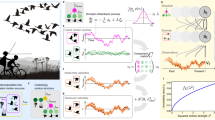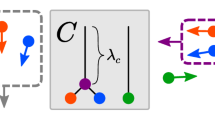Abstract
The pattern of local image velocities on the retina encodes important environmental information. Although humans are generally able to extract this information, they can easily be deceived into seeing incorrect velocities. We show that these 'illusions' arise naturally in a system that attempts to estimate local image velocity. We formulated a model of visual motion perception using standard estimation theory, under the assumptions that (i) there is noise in the initial measurements and (ii) slower motions are more likely to occur than faster ones. We found that specific instantiation of such a velocity estimator can account for a wide variety of psychophysical phenomena.
This is a preview of subscription content, access via your institution
Access options
Subscribe to this journal
Receive 12 print issues and online access
$209.00 per year
only $17.42 per issue
Buy this article
- Purchase on Springer Link
- Instant access to full article PDF
Prices may be subject to local taxes which are calculated during checkout





Similar content being viewed by others
References
Nakayama, K. Biological image motion processing: a review. Vision Res. 25, 625–660 (1985).
Horn, B.K.P. & Schunck, B.G. Determining optical flow. Artif. Intell. 17(1–3), 185–203 (1981).
Lucas, B.D. & Kanade, T. An iterative image registration technique with an application to stereo vision. in Proceedings of the 7th International Joint Conference on Artificial Intelligence 674–679 (Morgan-Kaufmann, San Fransisco, 1981).
Wuerger, S., Shapley, R. & Rubin, N. On the visually perceived direction of motion by Hans Wallach: 60 years later. Perception 25, 1317–1367 (1996).
Wallach, H. Ueber visuell whargenommene bewegungrichtung. Psychol. Forsch. 20, 325–380 (1935).
Marr, D. & Ullman, S. Directional selectivity and its use in early visual processing. Proc. R. Soc. Lond. B Biol. Sci. 211, 151–180 (1981).
Adelson, E. & Movshon, J. Phenomenal coherence of moving visual patterns. Nature 300, 523–525 (1982).
Movshon, A., Adelson, E., Gizzi, M. & Newsome, W. The analysis of moving visual patterns. Exp. Brain Res. 11, 117–152 (1986).
Welch, L. The perception of moving plaids reveals two processing stages. Nature 337, 734–736 (1989).
Morgan, M. Spatial filtering precedes motion detection. Nature 355, 344–346 (1992).
Schrater, P., Knill, D. & Simoncelli, E. Mechanisms of visual motion detection. Nat. Neurosci. 3, 64–68 (2000).
Rodman, H. & Albright, T. Single-unit analysis of pattern motion selective properties in the middle temporal visual area MT. Exp. Brain Res. 75, 53–64 (1989).
Movshon, J.A. & Newsome, W.T. Visual response properties of striate cortical neurons projecting to area MT in macaque monkeys. Vis. Neurosci. 16, 7733–7741 (1996).
Okamoto, H. et al. MT neurons in the macaque exhibited two types of bimodal direction tuning as predicted by a model for visual motion detection. Vision Res. 39, 3465–3479 (1999).
Ferrera, V. & Wilson, H. Perceived direction of moving two-dimensional patterns. Vision Res. 30, 273–287 (1990).
Mingolla, E., Todd, J. & Norman, J. The perception of globally coherent motion. Vision Res. 32, 1015–1031 (1992).
Yo, C. & Wilson, H. Perceived direction of moving two-dimensional patterns depends on duration, contrast, and eccentricity. Vision Res. 32, 135–147 (1992).
Burke, D. & Wenderoth, P. The effect of interactions between one-dimensional component gratings on two dimensional motion perception. Vision Res. 33, 343–350 (1993).
Bowns, L. Evidence for a feature tracking explanation of why type II plaids move in the vector sum directions at short durations. Vision Res. 36, 3685–3694 (1996).
Stone, L., Watson, A. & Mulligan, J. Effect of contrast on the perceived direction of a moving plaid. Vision Res. 30, 1049–1067 (1990).
Rubin, N. & Hochstein, S. Isolating the effect of one-dimensional motion signals on the perceived direction of moving two-dimensional objects. Vision Res. 33, 1385–1396 (1993).
Helmholtz, H. Treatise on Physiological Optics (Thoemmes, Bristol, UK, 2000; original publication 1866).
Knill, D. & Richards, W. Perception as Bayesian Inference (Cambridge Univ. Press, Cambridge, 1996).
Ascher, D. & Grzywacz, N. A Bayesian model for the measurement of visual velocity. Vision Res. 40, 3427–3434 (2000).
Koechlin, E., Anton, J.L. & Burnod, Y. Bayesian inference in populations of cortical neurons: a model of motion integration and segmentation in area MT. Biol. Cybern. 80, 25–44 (1999).
Simoncelli, E., Adelson, E. & Heeger, D. in Proc. IEEE Conf. Comput. Vision Pattern Recog. 310–315 (IEEE, Washington DC, 1991).
Heeger, D.J. & Simoncelli, E.P. in Spatial Vision in Humans and Robots Ch. 19 (eds. Harris, L. & Jenkin, M.) 367–392 (Cambridge Univ. Press, 1994).
Simoncelli, E.P. Distributed Representation and Analysis of Visual Motion. Thesis, Massachusetts Institute of Technology (1993).
Weiss, Y. Bayesian Motion Estimation and Segmentation. Thesis, Massachusetts Institute of Technology (1998).
Ullman, S. The Interpretation of Visual Motion (MIT Press, Cambridge, Massachusetts, 1979).
Stone, L. & Thompson, P. Human speed perception is contrast dependent. Vision Res. 32, 1535–1549 (1990).
Lorenceau, J., Shiffrar, M., Wells, N. & Castet, E. Different motion sensitive units are involved in recovering the direction of moving lines. Vision Res. 33, 1207–1217 (1992).
Thompson, P. Perceived rate of movement depends on contrast. Vision Res. 22, 377–380 (1982).
Thompson, P., Stone, L. & Swash, S. Speed estimates from grating patches are not contrast normalized. Vision Res. 36, 667–674 (1996).
Blakemore, M. & Snowden, R. The effect of contrast upon perceived speed: a general phenomenon? Perception 28, 33–48 (1999).
Snowden, R.N., Stimpson, N. & Ruddle, S. Speed perception fogs up as visibility drops. Nature 392, 450 (1998).
Wilson, H., Ferrera, V. & Yo, C. A psychophysically motivated model for two-dimensional motion perception. Vis. Neurosci. 9, 79–97 (1992).
Weiss, Y. & Fleet, D. in Probabilistic Models of the Brain Ch. 4 (eds. Rao, R., Olshausen, B. & Lewicki, M.) 77–96 (MIT Press, Cambridge, Massachusetts, 2002).
Nowlan, S.J. & Sejnowski, T.J. A selection model for motion processing in area MT of primates. J. Neurosci. 15, 1195–1214 (1995).
Simoncelli, E. & Heeger, D. A model of neuronal responses in visual area MT. Vision Res. 38, 743–761 (1998).
Pouget, A., Dayan, P. & Zemel, R. Information processing with population codes. Nat. Rev. Neurosci. 1, 125–32 (2000).
Grzywacz, N. & Yuille, A. Theories for the visual perception of local velocity and coherent motion. in Computational Models of Visual Processing (eds. Landy, J. & Movshon, J.) 231–252 (MIT Press, Cambridge, Massachusetts, 1991).
Acknowledgements
Y.W. and E.H.A. were supported by US National Eye Institute R01 EY11005 to E.H.A. E.P.S. was supported by the Howard Hughes Medical Institute and the Sloan-Swartz Center for Theoretical Visual Neuroscience at New York University. We thank J. McDermott, M. Banks, M. Landy, W. Geisler and the anonymous referees for comments on previous versions of this manuscript.
Author information
Authors and Affiliations
Corresponding author
Ethics declarations
Competing interests
The authors declare no competing financial interests.
Supplementary information
Rights and permissions
About this article
Cite this article
Weiss, Y., Simoncelli, E. & Adelson, E. Motion illusions as optimal percepts. Nat Neurosci 5, 598–604 (2002). https://doi.org/10.1038/nn0602-858
Received:
Accepted:
Published:
Issue Date:
DOI: https://doi.org/10.1038/nn0602-858
This article is cited by
-
A unifying theory explains seemingly contradictory biases in perceptual estimation
Nature Neuroscience (2024)
-
Representing stimulus motion with waves in adaptive neural fields
Journal of Computational Neuroscience (2024)
-
Multivariate EEG activity reflects the Bayesian integration and the integrated Galilean relative velocity of sensory motion during sensorimotor behavior
Communications Biology (2023)
-
Perception needs modular stimulus-control
Synthese (2023)
-
Neural structure of a sensory decoder for motor control
Nature Communications (2022)



